Index
PDA-RobE: Process-driven, continuous and automated robotics engineering
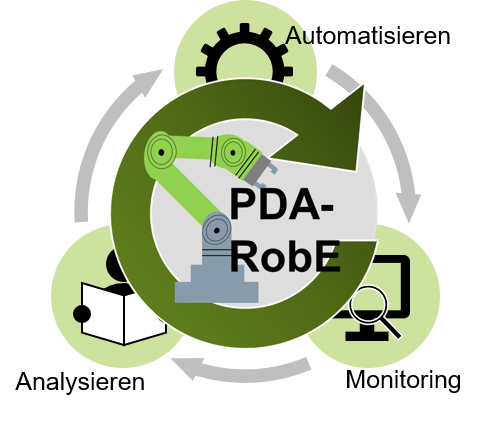
The PDA-RobE research project (process-driven, continuous and automated robotics engineering) has been funded by the Bavarian Ministry of Economic Affairs, Regional Development and Energy (StMWi) since 1 September 2021 and can be assigned to the “Artificial Intelligence – Big Data” initiative within the BAYERN DIGITAL strategy. In addition to the Institue for Factory Automation and Production Systems, the industrial partners exentra GmbH and Conti Temic microelectronic GmbH are involved in the research project over a period of 3 years. The aim is to develop a process-oriented project management software that guides users through the engineering processes in an intuitive way and at the same time provides relevant tools, services and information at the right time.
Detailed description:
There are many non-automated process steps within engineering and the project management required for its coordination. This situation is very costly, time-consuming and error-prone. The aim of PDA-RobE is therefore to accelerate the transformation from pure management and engineering process documentation and monitoring to automated process coordination and execution in the sense of continous end-to-end engineering or Industry 4.0. For this purpose, approaches from business informatics are transferred to the engineering of robot-based automation solutions or the digital twin. Along a process-oriented workflow management system, a reference architecture and application for engineering will be created, with a focus on the factory life cycle. An engineering project at Conti is used as a use case. The associated management workflows for planning robot-based automation solutions are modelled on the basis of Business Process Model and Notation (BPMN) and executed using a process engine in combination with engineering services. This allows the costs incurred and the time taken for engineering to be sustainably reduced and the quality of the processes to be increased through transparency.
Addressed research topics:
- Sustainable, optimised and transparent project management
- Process modelling and execution using Business Process Model and Notation (BPMN)
- Continous End-to-end engineering using the Process Driven Approach (PDA)
- Multi-user collaboration and planning through immersive Extended Reality (XR) services
- Support in planning through artificial intelligence (AI)
- Centralised knowledge and data management (Big Data)
DC|hyPASim – Digital planning and simulation of hybrid AC/DC power grids in automated production plants

The DC|hyPASim project aims to identify and harness unused energy saving potential in the manufacturing industry. In the course of this, technical measures to control the natural fluctuation of renewable energy sources will be evaluated in the context of future energy supply. Overall, investment costs will be reduced (by eliminating a large number of power supply units and converters), energy consumption will be lowered (by reducing power conversion processes), companies’ ability to innovate will be strengthened (by means of new products) and a path to CO2-neutral production will be shown. To achieve this goal, DC grids or hybrid structures consisting of DC and AC grids are used, with which, for example, regenerative energy or recuperation energy from electric drives can be exchanged or stored efficiently and intelligently.
In the project digital models will be used to test how DC branches can be linked to industrial networks in a time- and cost-efficient manner. The usable result will be a digital planning landscape and a prototype implementation of the concept. The feasibility of the new supply concept will be tested by means of a demonstrator system to be developed for decentralised DC grid branches with generators, storage units and consumers.
DC|hyPASim is funded as part of the AiF call for proposals “Leading Technologies for the Energy Transition”.
Furthermore, the project advisory committee consists of more than 30 partners from industry and renowned research associations.
Addressed research focus areas
- Dimensioning of hybrid AC/DC energy grids with generators, storage units and consumers based on an own DC demonstrator
- Planning landscape with digital twin
- Linking the electrical system behaviour (energy level) with the digital models of the production facilities (process level)
- Holistic protection and control concept for hybrid network architectures
- Software-based economic assessment of such networks
InterAcDT – Interactive-collaborative Digital Twin for Simulation based Planning and Optimization of Automated Production Plants
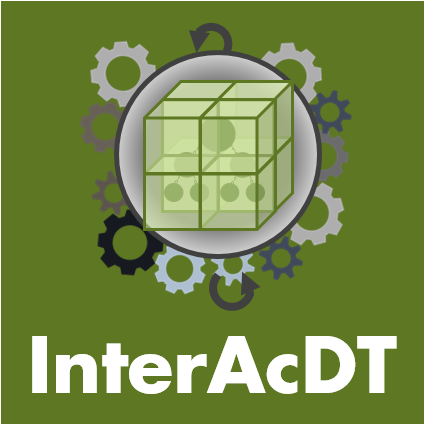
InterAcDT pursues further development of the “Digital Twin” for planning and optimization of production facilities. Through targeted development, combination and integration of technologies from the fields of simulation, AI as well as VR/AR, the Digital Twin of the production resource is:
- functionally extended,
- made available to a wider range of users via new interaction methods and the use of web technologies,
- and illustrated and made accessible with an accompanying application methodology.
Thus, the interaction with the digital plant twin, which is currently monopolized by simulation experts, is to be developed into an approach of collaborative use of digital twins. The resulting, collaboratively usable digital twin of a plant with new optimization functions enables an increase in the quality of planning and an economical production of, for example, new types of drive technologies in Germany.
ROBOTOP: Modular, Open and Internet-based Platform for Robot Applications in Industry and Service

The collaborative research project ROBOTOP (Modular, Open and Internet-based Platform for Robot Applications in Industry and Service) with the sub-project of the Institute of Factory Automation and Production Systems MyRoboBase (Modular, Internet-based Robotics Base Configurator) is funded by the German Federal Ministry for Economic Affairs and Energy (BMWi) from 01.06.2017. In the research network, 4 research and 4 industrial partners are involved over a period of three years. On the research side, the addressed topics are focused by partners of the Friedrich-Alexander-University Erlangen-Nuremberg, Technical University Dortmund, Ruhr-University Bochum and the Karlsruhe Institute of Technology.
Abstract of the project:
The development of a modular, internet-based and open robot platform (ROBOTOP) serves to open up the mass market for robots in service and manufacturing applications. Through a significant increase in quantities, the intelligent standardization and reuse of software, hardware and peripheral components, as well as the significant reduction of supply and engineering expenses, pronounced cost reductions can be developed in the context of planning and designing industrial service robotics solutions. ROBOTOP is a reference project for a modular platform for the planning and simulation of robot-based systems, which enables the work-sharing development, application and marketing of robots in the fields of industry, service as well as the private environment. The use of universal engineering tools and standardized interfaces for kinematics and effectors will enable a fast implementation of the concepts. The development of a transferable system architecture as well as methods and technologies for the base configurator represent the core work packages of the sub-project MyRoboBase carried out by the chair FAPS.
Duration: 06/2017 – 12/2020
Contact:

About PAiCE – Digital Technologies for the Economy:
The German Federal Ministry for Economic Affairs and Energy (BMWi) is currently funding 16 funded projects from science and industry with around 50 million euros through the technology program “Digital Technologies for the Economy (PAiCE)”, which tests the use of digital technologies in industrial processes and applications. The program focuses on the development of digital industrial platforms and collaboration between companies via the platforms. In addition, accompanying research activities will address issues and challenges regarding the law, business models and trustworthy architectures. For more information, please visit: www.paice.de
Reduction of energy consumption and CO2 emissions and enhancement of the resource efficiency through a state-oriented regulation of the manufacturing process in calcium silicate masonry unit plants – operational simulation with integration of real-time data
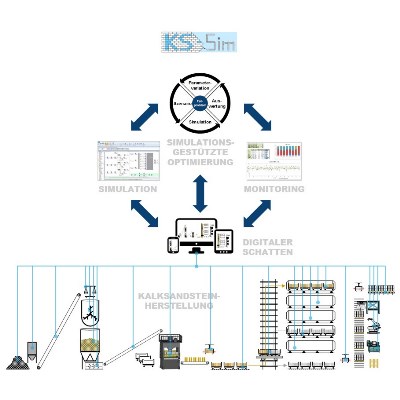
In industrial enterprises, owing to a lack of real-time data acquisition, manufacturing orders are generated based on an estimated future current state and thus lately deployed. They therefore do not regulate the current state of production and are therefore not suited to respond to short-term deviations – in particular not resource-optimally.
In a past research project the FAPS Institute enabled an accurate simulation and optimization of material and energy flows in calcium silicate masonry unit (CS) manufacturing plants, adapted for long-term simulation studies. The two-year research project “KS-Sim II” aims to convert this methodology for a short-term control or rather regulation of the production processes. This real-time operational simulation will be able to optimize and control production processes according to the current state of the production system. In addition, it is intended to identify and forecast deviations from the target by means of continuous monitoring and, if necessary, compensate them automatically through rescheduling. The long-term planning tool of the simulation finds the way into the short-term regulation of the production processes.
The technical finesses are being supported through the contribution of Professor Schuderer from the Technische Hochschule Ingolstadt, whose competent team is focussed on business informatics and logistics. Additionally, nine CS manufacturers are sharing their immense process-related knowledge and thereby guarantee the applicability. The project coordination is taken on by the AiF-Forschungsvereinigung Kalk-Sand e.V.
adidas Speedfactory Digital Twin
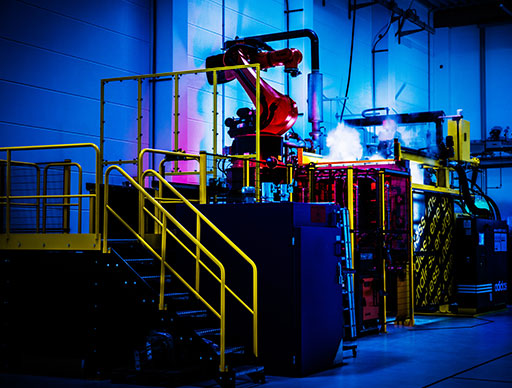
The adidas Speedfactory is a multi-phase project, which should bring manufacturing capacities back to Germany. Phase 1 was completed in the SEP 2016 and included the production of 1000 pairs of performance sports shoes. Phase 2 started in the first quarter of 2017 and aims at a blueprint for a significant upscaling of the volume, which will take place over the next 5 years.
Local manufacturing offers several advantages, including the approach to consumers, and the ability to react faster to their needs, reducing the lead time to deliver products, more transparency in operations, speed, flexibility, and lot size 1.
adidas aims to develop a digital twin of the Speedfactory to accelerate technology development, commissioning, optimization of production planning and execution.
E|KoWiss: Holistic knowledge-based energy dat management system
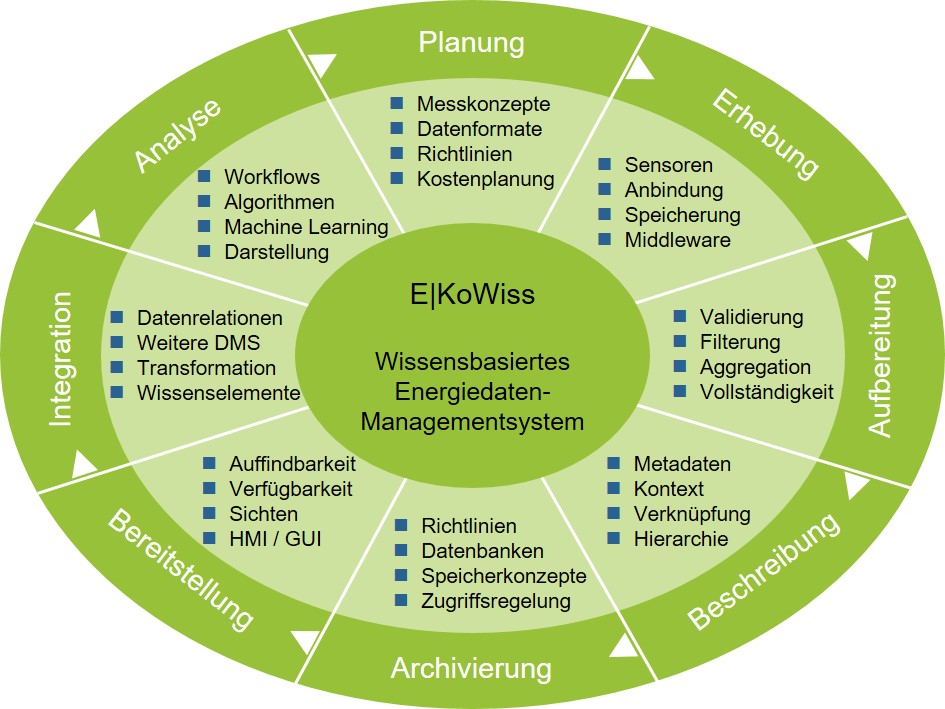
The project E|KoWiss is to provide an energy data management system which is capable of representing energy and resource consumption in the production in any granularity. In addition, the consumption data collected in the production process are to be enriched with semantic information in order to facilitate a simplified data evaluation. Furthermore, an interface to other data management systems, such as ERP, quality management or maintenance systems, is to be created in order to embed the collected data in a global context. This enables the identification of potential savings as well as the derivation of further potential for improvement in production. Ultimately, the information created can be linked to existing knowledge. In this way, a system is provided which automatically identifies optimization potentials and provides user-specific measures for improving production.
Need for action
- Automatic recording, monitoring and calibration of energy consumption with an energy data management system
- Automated evaluation of the recorded energy data
- Automated selection of energy efficiency measures as well as recommendations for machine and building maintenance to ensure sustainable energy efficiency
- Transfer of results to automated plant management
Project goals
- Transparent view of the energy consumption during the production of a specific product group and the related process steps, as well as general, non-assignable energy consumption
- Definition of hierarchical energy levels as standard for production cells
- Development of an automated workflow for the autonomous acquisition and evaluation of process and plant-related energy consumption
- Automated identification and quantification of potential savings through the use of machine learning
- Derivation of relevant measures for the sustainable energetic improvement of automated production lines by using an energy efficiency knowledge management system
UCM: Universal Contacting Modules
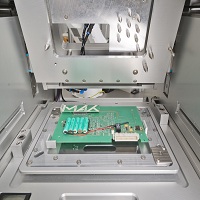
On one hand, the development of flexible inspection modules (test cells) which are
a. designed for a certain range of automotive control units (PCBs),
b. applicable and reusable in various stages of production (sampling, functional testing, etc.)
c. flexible to be used as stand-alone or inline solution both with manual and /or robotic operation considering variable production scales.
On the other hand concepts are developed that allow a simple production planning (simulation and optimization) and an optimized setup logistic. For the customers from automotive industry, the system lowers fixed costs and increases both the period of use of system modules and the knowledge to master changes in scale without frictions.
FOREnergy: Energy flexibility in production
The basis of the collaborative project FOREnergy is a basic understanding of the energy profiles in the factory. For such an understanding a holistic transparency in terms of energy requirements, energy fluctuations and flexible control approaches of energy are necessary. Currently the industry is usually not able to represent this transparent state of knowledge. Factories that are energetically monitored at installation level, are still an exception. In addition, energy flexibilities of existing facilities and equipment are often unknown.
The objective of the subproject 1 on which the FAPS is involved is to create this transparency. First, particularly energy-intensive and -variable areas should be identified in the companies. In the second step energy profiles of these areas will be created. The resulting energy models represent the basis for the control of energy demand of the relevant production areas. Additional an online measurement concept is developed, which will ensure the permanent transparency in production.
eProduction: Production oriented research related to high voltage batteries for electric mobility
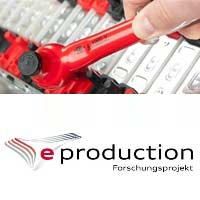
Methodological integration of assembly specific influences concerning high voltage components into virtual validation and assembly information systems:
Virtual validation (VV):
- Comparison of the VV at Audi with the state of research and high voltage assembly requirements =>Recommendations for error prevention and optimization as well as specification for software demonstrator
- Exploration of further virtual based analysis methods and scalable assembly concepts for HV components in electric vehicles; Testing the software demonstrator
- Verification of the software demonstrator by a Motion Capture System and evaluating of the VV methodic on the experimental prototype using the new software
Assembly information system (AIS):
- Data preparation for AIS using VV results in an easy and continuous way
- Implementation of an AIS prototype for electrified vehicles on the basis of the preliminary work of the Institute FAPS and Audi
